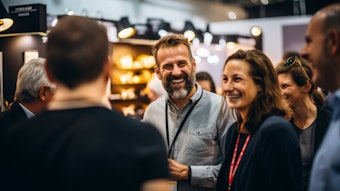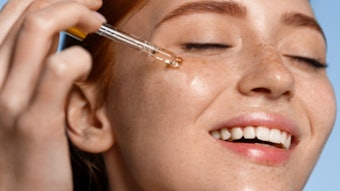GCI magazine was delighted to be a media partner for the Future Beauty & Body Visions 2006 conference held September 20–21 at the very glam London Art House, in London’s trendy Islington district.
This health and beauty summit, organized by Marketing Week magazine, highlighted strategic thinking for brands within the skin care, fragrance, cosmetics, hair care and personal care markets. Major themes included the men’s market, antiaging products/cosmeceuticals, natural products, the increasing use and importance of the Internet, and how to build and sustain successful brands in a choice-filled market.
In addition to the conference program of lectures and panel discussions, on-site beauty treatments and a hands-on perfumery workshop were available during refreshment breaks.
Proceedings were overseen by event chair Hilary Dart, former president of Calvin. Klein and former head of beauty development at Selfridges. Jeanne Chinard, founder and president of et y and LLC, got the conference off to a thought-provoking start with her fable of the girl who cried “new,” which noted that out of the tens of thousands of product introductions each year, only a few succeed. “The party is over for new,” said Chinard. Companies lose credibility by presenting slight incremental differences in products touted as “new,” spending millions of dollars distinguishing these microscopic differences. Companies should make sure that products are really new and different, singling the product out in order to succeed. Brand strengths should be communicated over time to slowly build up confidence in the brand, as demonstrated by Estée Lauder.
The Internet: Cult Replaces Niche
The first beauty panel discussion conversed on the impact of the Internet’s immediacy, from consumers to promotional campaigns and data capture, and how it can lead to increased knowledge of trends and consumers.
Men’s grooming was explored by John Gallo, Anthony Logistics, who described “deciphering the code.” With the male grooming growth, a major requirement is teaching men how to take care of their skin and making them feel comfortable with and willing to create different habits. The male grooming panel session emphasized the great potential for the men’s market, provided that male consumers are approached with appealing language and presentation.
Another area of growth is cosmeceuticals, described as bringing skin back to health. These active cosmetics offer beauty solutions mimicking cosmetic surgery without the downside/downtime associated with surgery. John Nolan-Neylan, The Natraceutical Company, covered the potential growth areas—such as natural cosmeceuticals, advanced science brands, hybrid brands from nature and science, and new cosmetic alternatives to eye tucks and face-lifts. He stated that the next generation of products will produce results that are even more dramatic. In addition, the physician brands continue to mature and move into the mass-market.
Michelle Feeney, former vice president of global communications, MAC Cosmetics, argued that cult has replaced niche brands. She described people as joining rather than buying a brand, especially hair stylists and teenagers. In her experience with MAC, Feaney delved into the company to find hidden assets to create a strong and authentic brand that uses beauty, makeup artists, characteristic black uniforms and artistry. “Question yourself constantly as a brand, and be safe in what you are saying because brands are going everywhere through the Internet. Make sure staff knows clearly what the company is about,” she advised.
Nancy Cruickshank, managing director of Handbag Publishing, described three trends transforming online usage—including always-on broadband access, rising Internet experience levels and social computing such as MySpace and blogging. In this environment, strong brands cannot afford to lose control of their message. Within this environment, new ideas can be floated, products developed and potential problems spotted.
Readers online are the new experts, according to Kate Creasy, beauty director of Handbag.com. Online readers can provide survey information leading to targeted editorial and trendspotting. Maximizing online potential can be achieved through videos, expandable banners and interactivity that leads to data capture, according to Jenny Cossons, Condé Nast Interactive.
Failing Marketing Models
The next panel discussion covered the latest and most effective marketing tools, emphasizing brand values. Sanjay Bhandari, MD, Farmacia Chemists Ltd, described the Urban Healing concept—to “make people feel well in cities.” Successful niche entrepreneurial brands need to balance their goals and ethical stance, influencing how big they become.
Don’t listen to shoppers. That was the shocking advice delivered by Siemon Scamell-Katz, ID Magasin. “Shopping is not a rational experience, but people try to make sense of it,” said Scamell-Katz. A video example of a man shopping demonstrated that he did not act as he told a researcher he had. Traditional marketing models are failing, so the industry must create different connections with consumers, making good use of visuals at the retail level.
Joanne Thompson, Boots Co Plc, introduced the retailers’ perspective. Their research shows that its customers trust the company as an expert friend, due to its health care heritage. It has a unique balance of its private label products and great brand presence, offering a choice from premium to mass products. The Boots Advantage card has been a highly successful customer loyalty program, resulting in increased purchasing by cardholders. Recent redesigns and launches have made the in-store environment more appealing and increased ease of use for shoppers. A panel discussion followed on retailing strategies—such as the role of promotions and sampling.
Andy Knowles, Jones Knowle Ritchie, described the value of good design and how to make consumers’ buying decisions easier in an environment where there is too much choice. The value of a strong, charismatic brand was stressed, as it allowed consumers to choose quickly and confidently.
Joanna Norman and David Pybus, Pandora Ltd, provided an interactive fragrance demonstration that allowed delegates to find a perfume to match their star sign, look at fragrances taken from history and see different global perceptions of popular fragrances.
Marcos Angelini, Unilever, described the success of the Dove brand, its growth and its Campaign for Real Beauty. Unilever’s newest development is its Dove Spa opening in the U.K. with a range of Dove spa products.
Nica Lewis and Marie Caudwell, Guinot, discussed the professional beauty market, where the industry relies on the beauty therapist first and then the product. Training and education for these therapists is important to create trust and loyalty. Trends for the future of this segment include antiaging body care, men, eco awareness and spa experiences as gifts.
The conference was wrapped up by Kate Ancketill, GDR Creative Intelligence, discussing global trends and strategies and the latest distribution avenues and marketing techniques—online and in-store.










